All in a day's work at Bath Cricket Club
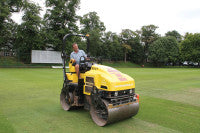 When our editor, Laurence Gale, arrived at Bath Cricket Club, Gordon Gill was busy rolling a wicket with a hired 2.5 tonne roller; his own was in for repair. He was preparing a wicket for the juniors to play on that evening and, whilst he had the roller out, he was progressing a couple of other wickets, giving them a preliminary roll and making good use of some rare sunny weather. In between all the rolling, he mowed out two practice wickets and started to cut the outfield using his John Deere 2653A triple mower. It's amazing to see the difference a bit of sunshine makes; the light and dark bands stood out really well.
When our editor, Laurence Gale, arrived at Bath Cricket Club, Gordon Gill was busy rolling a wicket with a hired 2.5 tonne roller; his own was in for repair. He was preparing a wicket for the juniors to play on that evening and, whilst he had the roller out, he was progressing a couple of other wickets, giving them a preliminary roll and making good use of some rare sunny weather. In between all the rolling, he mowed out two practice wickets and started to cut the outfield using his John Deere 2653A triple mower. It's amazing to see the difference a bit of sunshine makes; the light and dark bands stood out really well.
By mid afternoon, Gordon's assistant, Greg Brown, had returned from the club's second ground at Brownsword, just north of the city, and proceeded to help with rolling and marking out the junior pitch for the evening match.
Bath Cricket Club play at North Parade, which is situated next to the River Avon and only a two minutes walk from the city centre. A cricket pitch has been in existence on the site since 1859.
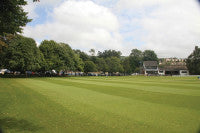
The club run four Saturday sides - the 1st and 2nd XIs play in the West of England Premier League and the 3rd and 4th XIs in the North Somerset League. On Sundays, the club run two sides, and there is a vibrant youth section with teams from Under 11 to Under 15 playing in local leagues and cup fixtures. There are also two ladies teams, a girls squad, a seniors XI and a midweek team.
The weather on the day of my visit was fantastic, a few clouds about, with the sun poking its nose from behind them at regular intervals and, shock horror, no rain! Air temperatures were rising nicely as the day progressed.
Gordon, like most cricket groundsmen this year, has spent the last three months trying to keep his pitches dry, pulling flat sheets and raised covers on and off as the weather dictates. This summer it has dictated they be on more than off, and this can cause all sorts of issues, not least the grass turning yellow, elongating growth as the plant searches for light, and sweating up the playing surface.
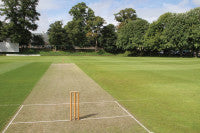 As well as the physical effort involved, wicket preparation could only be carried out sporadically, which is never ideal. Gordon has always prided himself on the quality of his wickets and says that, whilst this summer has stretched his patience, the wickets have been pretty good.
As well as the physical effort involved, wicket preparation could only be carried out sporadically, which is never ideal. Gordon has always prided himself on the quality of his wickets and says that, whilst this summer has stretched his patience, the wickets have been pretty good.
He praises the waterhog, which he brought out of retirement following a few years 'sabbatical'. It's been a godsend in terms of removing water off the flat sheets and areas of the outfield. It is one of a large collection of machinery in Gordon's arsenal that he had hidden away in his shed, and he was surprised it started so easily after been stood for so long.
The North Parade ground has quite a high water table, which is affected by River Avon. The club invested in a perimeter drain around the square several years ago to ensure it could drain easily. Water is collected and sent to a manhole deep under the outfield, which is then pumped into the river. This year, the pump has been on 24/7 just to keep the water levels under some sort of control. Gordon is able to manage the level so, in drier periods, he can switch the pump off, as required, to retain moisture in the outfield and square.
Gordon has been at Bath Cricket Club since April 2003 and, together with Greg, has transformed the club's two grounds. With two squares to maintain and over two 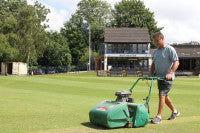 hundred wickets to prepare, he has his work cut out.
hundred wickets to prepare, he has his work cut out.
He has been involved in grounds maintenance for well over thirty years. He is also the ECB Cricket Pitch Adviser for Wiltshire, which involves visiting clubs and assessing facilities within the county. He is also one of Pitchcare's well respected team of training instructors delivering cricket courses.
Over the years the club has acquired a wide range of mowing, rolling, aerating and scarifying machines. These include a Graden scarifier, a Ransomes Auto Certes, a Jacobsen Tri-King, Sisis Autorake, John Deere 2653A triple mower, Poweroll 12 and an Auto-Roller.
Gordon supervised the reconstructing of all sixteen pitches on the main square, which began in 2006 and was completed in 2009. Every pitch was dug up, taking out 100mm of the old soil and replacing with Boughton County Loam. Each year the performance of these new wickets continues to improve, with all now producing better consistent pace and bounce.

Gordon spends many hours preparing and maintaining his facilities. He believes you never stop learning in this industry, as there are always new challenges to face from both the weather - and the players! He has learned to work with what he has and tries to produce the best wickets in the time he has. Weather is the key factor and usually dictates how, where and when pitch preparations takes place. This year has certainly tested his skills, and it has been a case of adapting the basic principles to fit within the time-frame available between the rain. Instead of the usual ten-fourteen days to prepare wickets, Gordon has had to produce them more quickly.
'Normal' preparations begin ten-fourteen days ahead of a fixture; the time allotted is dependant on the level of the fixture. The height of cut is reduced, in stages, from the general 12mm across the square to the 4mm match height.
Gordon will then spend up to three or four hours at a time to hand water the wicket - not needed so far this year - ensuring the water gets down below100mm. The wicket is then allowed to dry for up to two days days, prior to rolling with the 2-tonne Auto-Roller, averaging half an hour's rolling per day. Finally, the crease is marked out using string lines.
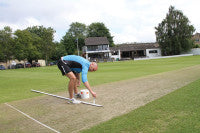 Once the wicket has been used, and this may be for more that one game, Gordon initiates a repair regime consisting of watering (soaking the strip if required), scarifying using the Graden set at approximately 3mm using 2mm blades, spiking between 25-75mm, overseeding and topdressing with loam at a rate of four 25kg bags per wicket. Once completed, the wicket is covered with a germination sheet. After six weeks, it can be brought back into play, if required.
Once the wicket has been used, and this may be for more that one game, Gordon initiates a repair regime consisting of watering (soaking the strip if required), scarifying using the Graden set at approximately 3mm using 2mm blades, spiking between 25-75mm, overseeding and topdressing with loam at a rate of four 25kg bags per wicket. Once completed, the wicket is covered with a germination sheet. After six weeks, it can be brought back into play, if required.
Gordon believes that preparing a good wicket comes with years of practice. He firmly believes that success is determined by the amount of time and effort taken on autumn renovation work, and that this determines the standard of the wickets for the following season.
End of season renovations at Bath take place as soon as possible after the last game, to make good use of the warm soil and air temperatures for seed germination. The square is mown in several directions to a height of approximately 2-3mm, leaving a very small amount of healthy vegetation to help the square recover quickly.
The square is then oversown with a mixture of dwarf perennial rye grasses; approximately 25kg to every five or six wickets. A fertiliser spinner is used to spread the  seed which, Gordon says, is an excellent way to distribute seed, allowing it to fall into the grooves made by the scarifier. If the ground surface is damp enough, a variseeder will be used as well. A combination of the two usually provides excellent results. A 6:9:6 pre-seeder fertiliser is then applied at 35gms per square metre, before finally topdressing with five or six 25kg bags of loam. This is worked into the surface using a combination of brushes, lutes, dragmats and ladders. Gordon pays a lot of attention to dragging the loam into the surface. It can sometimes take two or three individuals, with tractors, a couple of hours to complete this task alone. He is not happy until there is very little loose loam left on the surface, and that any vegetation is standing up through the loam and not lying buried underneath.
seed which, Gordon says, is an excellent way to distribute seed, allowing it to fall into the grooves made by the scarifier. If the ground surface is damp enough, a variseeder will be used as well. A combination of the two usually provides excellent results. A 6:9:6 pre-seeder fertiliser is then applied at 35gms per square metre, before finally topdressing with five or six 25kg bags of loam. This is worked into the surface using a combination of brushes, lutes, dragmats and ladders. Gordon pays a lot of attention to dragging the loam into the surface. It can sometimes take two or three individuals, with tractors, a couple of hours to complete this task alone. He is not happy until there is very little loose loam left on the surface, and that any vegetation is standing up through the loam and not lying buried underneath.
During the closed season the square is not fenced off, as the club very rarely suffers any vandalism or pest damage. Also, if somebody really does want to walk across the square when Gordon's back is turned, a rope or fence isn't going to deter them.
During the winter, the square and outfield are maintained at a cutting height of approximately 15mm. Winter aeration is carried out as often as possible, using 9mm tines vertically, through to about the middle of January.

The outfield is cut with the John Deere triple mower at least four times per week to a height of 9mm, and spiked throughout the year with a tractor mounted Groundsman aerator.
Gordon really enjoys the job. Hardly surprising when his 'office' is one of the most picturesque areas of one of the most revered cities in the country. Having been at the club for ten years he now feels very much part of the set-up and, more importantly, is now reaping the rewards of his work in the way the new pitches are performing.
What the future holds, no one knows, but surely next summer cannot be as bad as this year's in terms of rainfall, can it?
